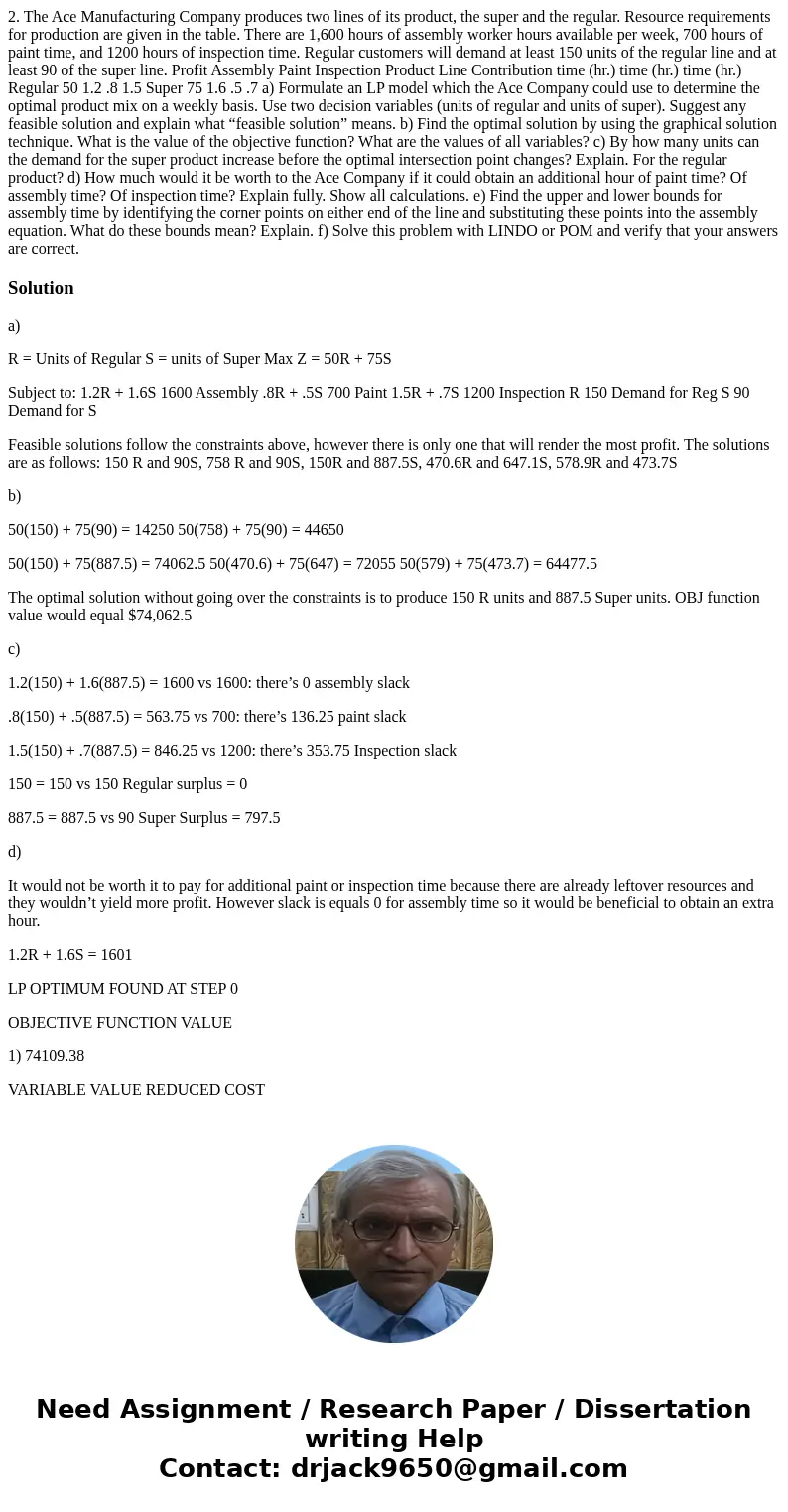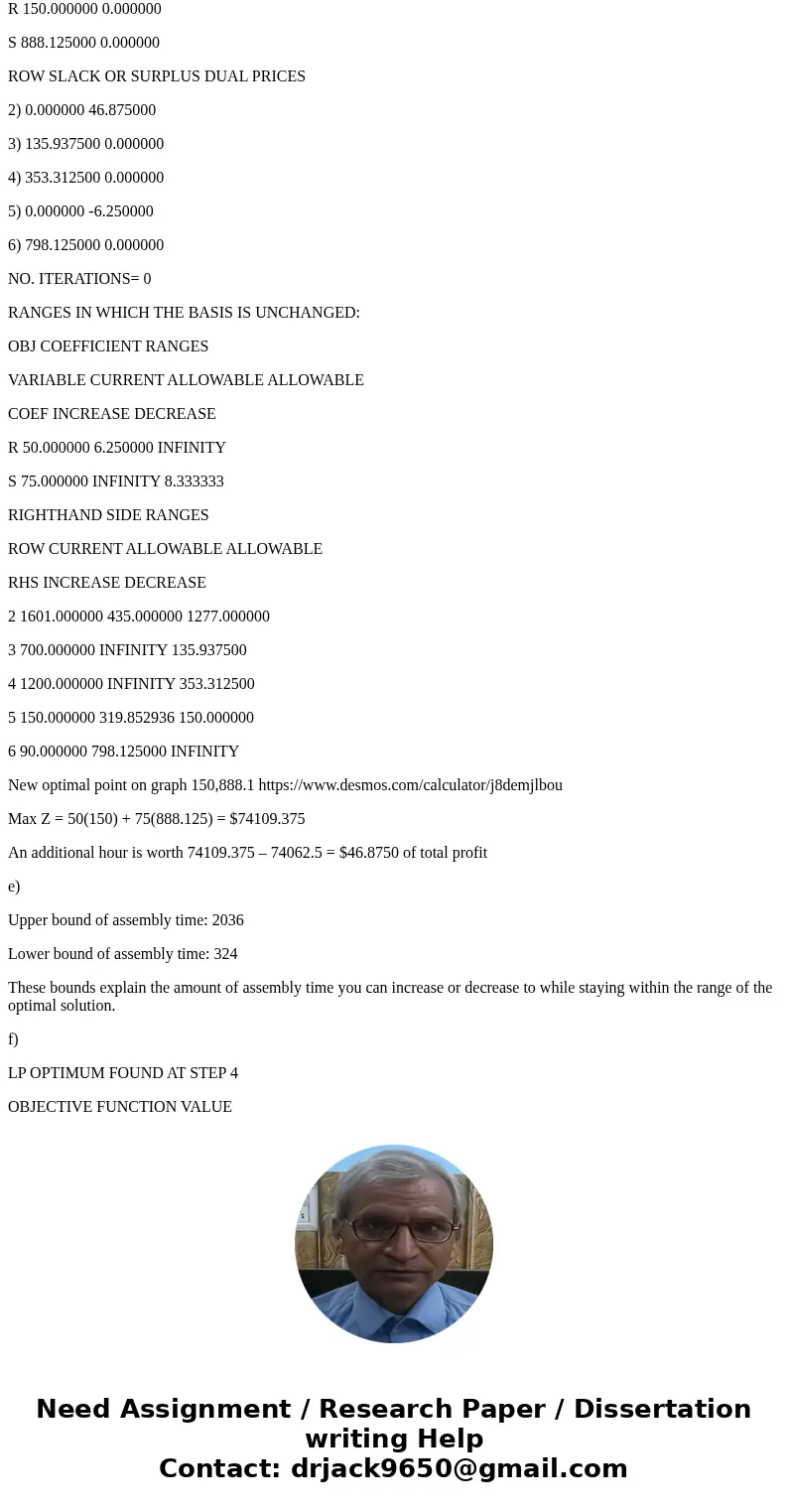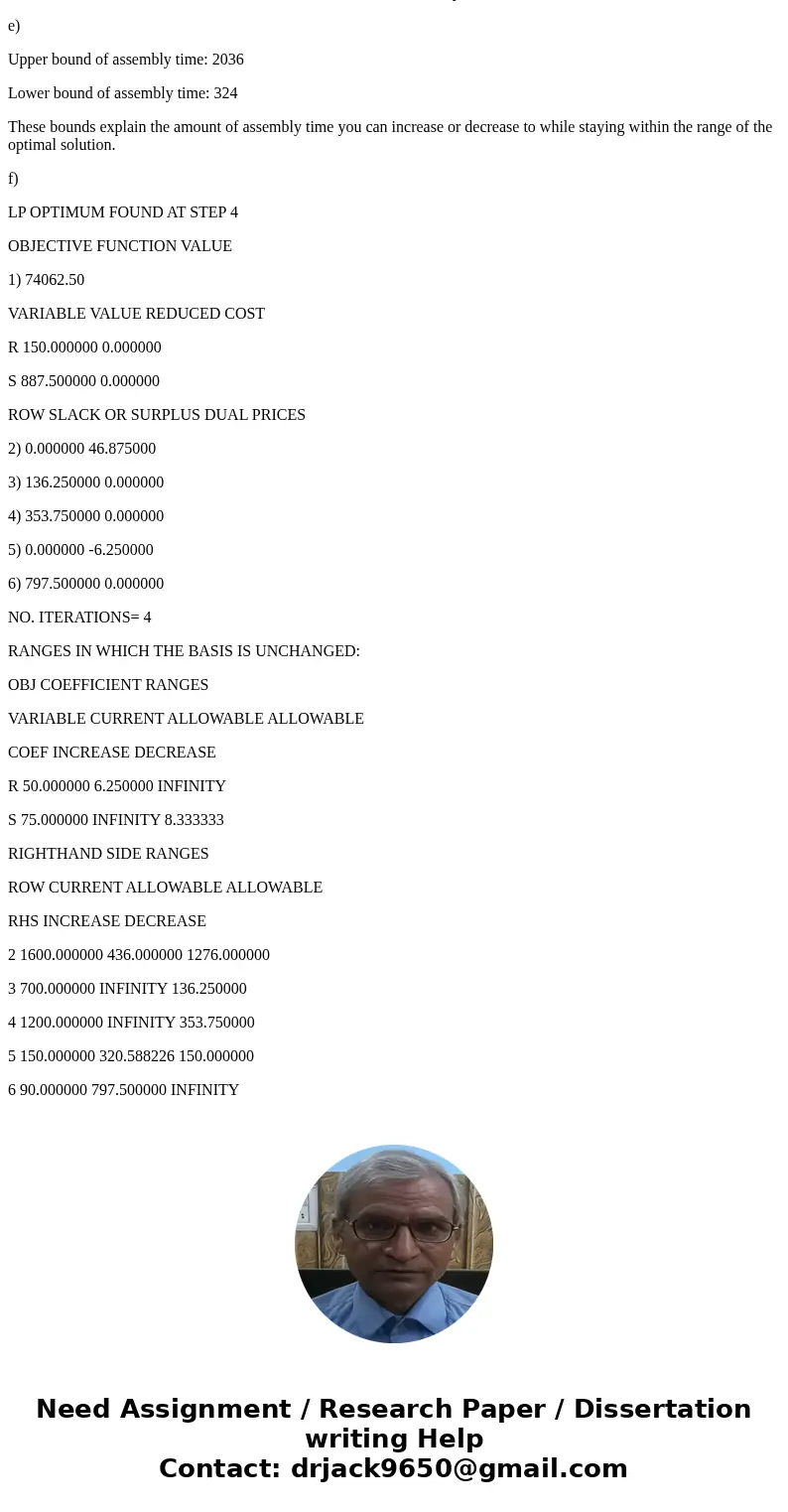2 The Ace Manufacturing Company produces two lines of its pr
2. The Ace Manufacturing Company produces two lines of its product, the super and the regular. Resource requirements for production are given in the table. There are 1,600 hours of assembly worker hours available per week, 700 hours of paint time, and 1200 hours of inspection time. Regular customers will demand at least 150 units of the regular line and at least 90 of the super line. Profit Assembly Paint Inspection Product Line Contribution time (hr.) time (hr.) time (hr.) Regular 50 1.2 .8 1.5 Super 75 1.6 .5 .7 a) Formulate an LP model which the Ace Company could use to determine the optimal product mix on a weekly basis. Use two decision variables (units of regular and units of super). Suggest any feasible solution and explain what “feasible solution” means. b) Find the optimal solution by using the graphical solution technique. What is the value of the objective function? What are the values of all variables? c) By how many units can the demand for the super product increase before the optimal intersection point changes? Explain. For the regular product? d) How much would it be worth to the Ace Company if it could obtain an additional hour of paint time? Of assembly time? Of inspection time? Explain fully. Show all calculations. e) Find the upper and lower bounds for assembly time by identifying the corner points on either end of the line and substituting these points into the assembly equation. What do these bounds mean? Explain. f) Solve this problem with LINDO or POM and verify that your answers are correct.
Solution
a)
R = Units of Regular S = units of Super Max Z = 50R + 75S
Subject to: 1.2R + 1.6S 1600 Assembly .8R + .5S 700 Paint 1.5R + .7S 1200 Inspection R 150 Demand for Reg S 90 Demand for S
Feasible solutions follow the constraints above, however there is only one that will render the most profit. The solutions are as follows: 150 R and 90S, 758 R and 90S, 150R and 887.5S, 470.6R and 647.1S, 578.9R and 473.7S
b)
50(150) + 75(90) = 14250 50(758) + 75(90) = 44650
50(150) + 75(887.5) = 74062.5 50(470.6) + 75(647) = 72055 50(579) + 75(473.7) = 64477.5
The optimal solution without going over the constraints is to produce 150 R units and 887.5 Super units. OBJ function value would equal $74,062.5
c)
1.2(150) + 1.6(887.5) = 1600 vs 1600: there’s 0 assembly slack
.8(150) + .5(887.5) = 563.75 vs 700: there’s 136.25 paint slack
1.5(150) + .7(887.5) = 846.25 vs 1200: there’s 353.75 Inspection slack
150 = 150 vs 150 Regular surplus = 0
887.5 = 887.5 vs 90 Super Surplus = 797.5
d)
It would not be worth it to pay for additional paint or inspection time because there are already leftover resources and they wouldn’t yield more profit. However slack is equals 0 for assembly time so it would be beneficial to obtain an extra hour.
1.2R + 1.6S = 1601
LP OPTIMUM FOUND AT STEP 0
OBJECTIVE FUNCTION VALUE
1) 74109.38
VARIABLE VALUE REDUCED COST
R 150.000000 0.000000
S 888.125000 0.000000
ROW SLACK OR SURPLUS DUAL PRICES
2) 0.000000 46.875000
3) 135.937500 0.000000
4) 353.312500 0.000000
5) 0.000000 -6.250000
6) 798.125000 0.000000
NO. ITERATIONS= 0
RANGES IN WHICH THE BASIS IS UNCHANGED:
OBJ COEFFICIENT RANGES
VARIABLE CURRENT ALLOWABLE ALLOWABLE
COEF INCREASE DECREASE
R 50.000000 6.250000 INFINITY
S 75.000000 INFINITY 8.333333
RIGHTHAND SIDE RANGES
ROW CURRENT ALLOWABLE ALLOWABLE
RHS INCREASE DECREASE
2 1601.000000 435.000000 1277.000000
3 700.000000 INFINITY 135.937500
4 1200.000000 INFINITY 353.312500
5 150.000000 319.852936 150.000000
6 90.000000 798.125000 INFINITY
New optimal point on graph 150,888.1 https://www.desmos.com/calculator/j8demjlbou
Max Z = 50(150) + 75(888.125) = $74109.375
An additional hour is worth 74109.375 – 74062.5 = $46.8750 of total profit
e)
Upper bound of assembly time: 2036
Lower bound of assembly time: 324
These bounds explain the amount of assembly time you can increase or decrease to while staying within the range of the optimal solution.
f)
LP OPTIMUM FOUND AT STEP 4
OBJECTIVE FUNCTION VALUE
1) 74062.50
VARIABLE VALUE REDUCED COST
R 150.000000 0.000000
S 887.500000 0.000000
ROW SLACK OR SURPLUS DUAL PRICES
2) 0.000000 46.875000
3) 136.250000 0.000000
4) 353.750000 0.000000
5) 0.000000 -6.250000
6) 797.500000 0.000000
NO. ITERATIONS= 4
RANGES IN WHICH THE BASIS IS UNCHANGED:
OBJ COEFFICIENT RANGES
VARIABLE CURRENT ALLOWABLE ALLOWABLE
COEF INCREASE DECREASE
R 50.000000 6.250000 INFINITY
S 75.000000 INFINITY 8.333333
RIGHTHAND SIDE RANGES
ROW CURRENT ALLOWABLE ALLOWABLE
RHS INCREASE DECREASE
2 1600.000000 436.000000 1276.000000
3 700.000000 INFINITY 136.250000
4 1200.000000 INFINITY 353.750000
5 150.000000 320.588226 150.000000
6 90.000000 797.500000 INFINITY



 Homework Sourse
Homework Sourse